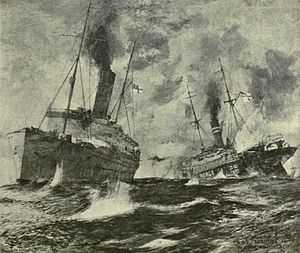Action of 29 February 1916
| Action of 29 February 1916 | |||||||
|---|---|---|---|---|---|---|---|
| Part of World War I | |||||||
 HMS Alcantara (left) and SMS Greif (right) duelling at close range. | |||||||
| |||||||
| Belligerents | |||||||
|
|
| ||||||
| Commanders and leaders | |||||||
|
| Tieze[1] | ||||||
| Strength | |||||||
|
1 light cruiser, 2 auxiliary cruisers, 1 destroyer | 1 auxiliary cruiser | ||||||
| Casualties and losses | |||||||
|
72 killed, 1 auxiliary cruiser sunk |
~187 killed, 125 captured, 1 auxiliary cruiser sunk | ||||||
The Action of 29 February 1916 was a naval battle fought during the First World War between the United Kingdom and the German Empire. A German commerce raider broke out into the North Sea and in response Admiral Sir John Jellicoe dispatched a fleet of Royal Navy warships to intercept the raider. Four British vessels made contact with the Germans and in the ensuing engagement two ships were sunk in a bloody engagement.
Background
Just converted, the 5,000 ton auxiliary cruiser SMS Greif was armed with four hidden 150 millimetres (5.9 in) guns, one hidden 105 millimetres (4.1 in) gun and two torpedo tubes. She was crewed by about 360 officers and men.
Greif departed her home port of Hamburg into the North Sea on February 27, intending to enter the Atlantic by an Icelandic route,[2] and a British submarine spotted her and reported her position to the Admiralty the next day.
Admiral Jellicoe sortied five cruisers and seven destroyers to sweep the North Sea with the auxiliary cruisers HMS Alcantara and HMS Andes which were already on patrol. The British auxiliary cruisers both weighed about 15,000 tons and carried eight 6-inch and two 3-pounders each. Four Royal Navy warships encountered Greif, including the two auxiliary cruisers, there was the light cruiser HMS Comus and the destroyer HMS Munster which arrived at the very end of the action.
Action
At about 8:45 am on February 19, 1916, lookouts aboard Alcantara spotted smoke off the port beam so her commander Captain Thomas Erskine Wardle manoeuvered closer to identify what the smoke was coming from. Unbeknownst to them the smoke was from SMS Greif. A few minutes later Andes reported that her lookouts had sighted a ship with two masts and a black funnel headed northeast. Two Norwegian steamers were also observed, flying their large flags. The two British vessels closed on Greif until within range to signal one another.
First Captain Wardle ordered the German vessel to stop and two blank rounds were fired. The Germans hove to and signaled that they were from Trondheim and were headed for Rio de Janeiro. At about 9:40 the British were close enough to the raider so they lowered a few boats with a boarding party to take command of the seemingly harmless steamer. At this moment the raider revealed her intentions, unmasked her guns and opened fire on Alcantara at a range of 800 yards. The first discharge struck Alcantara 's bridge which caused heavy damage and destroyed the communications equipment. Further shots hit and sank some of the boarding party's boats and also knocked out the Briton's steering gear.
Alcantara increased her speed and began returning fire as the Germans attempted to flee towards the Norwegian coastline. Her first shot struck and disabled Greif 's poop gun, killing the crew in the process. For several minutes the two vessels dueled at close range until gun fire was heard by Andes which was about five miles from the battle area. She closed to within three miles of SMS Greif and opened fire. Her first shots struck the bridge of the German raider and destroyed its steering gear. Greif launched two torpedoes at Alcantara; the first one hit amidship and the second passed under the stern. By the end of the engagement, the British knocked out another German gun and set her fuel tanks on fire, one shot entered the hull of Greif, exploded, and slowed the vessel to a sinking halt. Reports say that both Greif and Alcantara were struck several times at or below the waterline which left the British vessel in a sinking state as well. German fire ceased at 10:18 am and a few minutes later the Royal Navy sailors spotted life boats being lowered from the burning Greif.
The British kept up their fire and as the German commander climbed down the rope to his life boat, shrapnel struck him in the neck and he was beheaded. Several moments later Captain Wardle ordered his men to abandon ship and at 11:02 Alcantara was under water. Around this time Comus and Munster arrived and finished sinking the German raider. Wardle and his surviving crew were in the water for about twenty minutes before being picked up. An estimated 187 Germans perished along with seventy-two Britons, five officers and 120 Germans were rescued and taken prisoner by Andes and Munster.
Aftermath
Though the British managed to sink the raider, Captain Wardle lost his ship in the process. He was later criticized for maneuvering too close to the German raider before knowing its true identity. Assuming Greif was a harmless merchant ship cost Wardle his vessel and several men. Despite this he was recognized for bravery and awarded the Distinguished Service Order and eventually became a rear admiral.
Order of Battle
Royal Navy:
- HMS Comus, light cruiser
- HMS Alcantara, auxiliary cruiser, flagship
- HMS Andes, auxiliary cruiser
- HMS Munster, destroyer
German Navy:
- SMS Greif, auxiliary cruiser